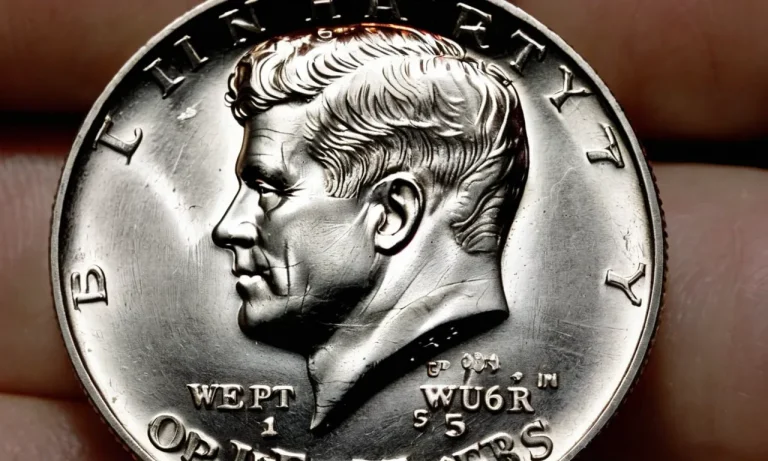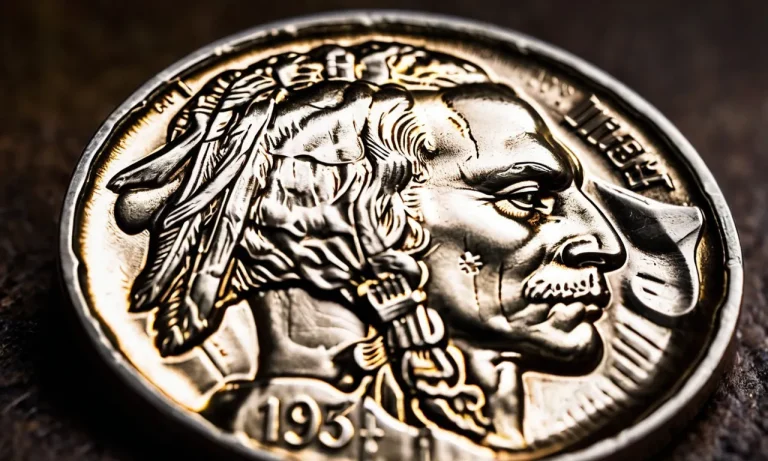What makes a 1976 silver dollar rare? Silver dollars have captivated coin collectors for decades, but some dates and variations stand out more than others when it comes to precious metal’s value and scarcity. If you’ve wondered what distinguishes a rare 1976 silver dollar, you’ve come to the right place.
In short, key elements that give 1976 silver dollars collectible value and rarity include low mintage, special commemorative issues, unique design elements like double dies, and pristine condition or special labels like “proof.”
Read on for more detail on the different factors that impact the 1976 silver dollar’s rarity and value.
Low Mintage 1976 Silver Dollars
1976-S Silver Proof Eisenhower Dollar
The 1976-S silver proof Eisenhower dollar had an extremely limited mintage of just 4,000,000 making it one of the rarest modern U.S. Mint-proof coins (United States Mint). This special edition-proof coin was struck at the San Francisco Mint and intended solely for collectors rather than general circulation.
It features a mirror-like proof finish and Eisenhower’s profile on the obverse, with the U.S. national emblem eagle in flight on the reverse.
Since the total number struck was 4 million, the 1976-S Eisenhower silver dollar is considered very scarce by numismatic standards. By comparison, most proof Eisenhower dollars had mintages over 3 times higher. A few key factors contribute to the value of proof Eisenhower dollars:
- Condition – Proof coins should have no signs of wear and tear or damage
- Grade – Higher numeric grades from coin grading services like NGC mean higher value
- Original Mint Packaging – Having the original box and COA raises value significantly
According to the NGC price guide, 1976-S proof Eisenhower dollars can be worth anywhere from around $25 to $4,500+ depending on grade and if they still have the original packaging. So it certainly pays to protect any you own!
1976-S Silver Bicentennial Eisenhower Dollar
In honor of the 200th anniversary of American independence, the U.S. Mint struck special bicentennial edition Eisenhower silver dollars dated 1776-1976. The proof version, with a mintage of 4,000,000 is considered the rarest bicentennial proof coin.
These historic silver dollars feature a dual date on the normal Eisenhower obverse designed by Chief Engraver Frank Gasparro. The reverse depicts Independence Hall in Philadelphia where the Declaration of Independence was signed in 1776. The building is flanked by the Liberty Bell and the moon.
According to the PCGS CoinFacts, the typical 1976-S bicentennial silver proof Eisenhower dollar trades for around $40-50 in PR65 condition. However, examples graded PR69 can sell for $300 or more. So proper storage and avoiding imperfections is key to maintaining high value.
| Key Date | Mintage | Average Retail Value |
| 1976-S silver proof Eisenhower dollar | 4,000,000 | $25 to $4,500+ (NGC) |
| 1976-S silver bicentennial proof Eisenhower dollar | 4,908,319 | $40 to $300+ (PCGS) |
1976 Silver Dollars With Errors and Varieties
1976 Eisenhower Dollars With Doubled Dies
The 1976 Eisenhower dollar with a doubled die is one of the more well-known and valuable error coins from the 1976 silver dollar. This rare variety exhibits a strong doubling of the lettering, dates, mint mark, and design elements on the obverse (front) of the coin.
According to the authoritative coin price guide Grey Sheet, an uncirculated 1976 Eisenhower silver dollar with a particularly dramatic doubled die sold at auction in 2018 for over $12,500.
Only a small number of the 1976-dated Eisenhower dollars were struck with this dramatic doubled die error. The doubling occurred early in the minting process when the coin’s obverse die impression struck two impressions very closely together on the coin blank.
The total number of identified 1976 Eisenhower doubled die error coins is estimated at around 20-30 examples.
Other less dramatic doubled dies also exist on 1976 Eisenhower silver dollars, but the coins still carry significant premiums over common Eisenhower dollars from that year. For example, one 1976-D Eisenhower dollar with minor doubled lettering still fetched over $2,000 at auction in 2015 according to numismatic archives.
1976-D Bicentennial Silver Dollar Misaligned Dies
Another famous rarity in the 1976 silver dollar series is the 1976-D Bicentennial dollar struck with misaligned dies. On normal aligned dies, the obverse and reverse designs match up evenly when you flip the coin.
On coins with misaligned dies, the two sides do not match evenly because the dies were slightly turned or rotated during striking.
The extent of die rotation varies in misaligned die coins. Slight rotations of 5-15 degrees are more common. But coins with very dramatic rotations approaching 90 degrees (or “railroad” rotations) are extraordinarily rare.
PCGS CoinFacts estimates under 10 examples of a 90-degree 1976-D Bicentennial silver dollar are known to collectors and specialists.
Due to the popularity of Bicentennial coinage, even minor die rotations are valuable. A lightly rotated 1976-D silver dollar might sell for $100+ compared to $3-4 for a common uncirculated example. But extremely rotated coins trade for anywhere from $3,000 to over $20,000 at auction according to references like Heritage Auctions archives.
Importance of Condition for Rare Coins
The condition of a rare coin plays a critical role in determining its value to collectors. Here’s why the state of preservation is so important for rare 1976 silver dollars and other collectible coins:
Higher Grades Mean Higher Prices
In numismatics, a grading scale is used to assess the condition of coins on a numeric scale – the higher the grade, the better preserved the coin. For rare coins like the 1976 silver dollar, a mint state (MS) grade of MS-65 or higher can mean a value that is many times greater than a lower grade of MS-60.
Even small differences in grade can equate to large premiums for buyers.
Condition Rarity
Some rare date coins are abundant in lower circulated grades but quite elusive in the finest preserved conditions. For the 1976 silver dollar, finding specimens in pristine MS-67 or MS-68 condition is exceptionally difficult.
So coins at this level are considered “condition rarities” that sell for high premiums owing to their scarcity and the strong collector demand for top-grade examples.
Long Term Value Appreciation
Investors are often drawn to rare coins in the best possible condition due to their long-term value growth prospects. As time passes, the gap between high-grade and low-grade examples tends to widen – so buyers are willing to pay substantially more for finely preserved coins.
What is an expensive MS-67 today could be considered virtually priceless decades later!
In summary, condition rarity, grade-based premiums, and long-term appreciation potential make nicely preserved rare coins like the 1976-S silver dollar far more valuable to own. This importance of the state of preservation underscores why astute collectors seek out the very finest specimens possible.
Special Label 1976 Silver Dollars
1976 Silver Dollars with First Day of Issue Labels
The 1976 silver dollar marked the first time since 1945 that the U.S. Mint issued silver dollars for general circulation. To commemorate this event, some 1976 dollars were specially packaged with “First Day of Issue” certificates or labels.
These labels varied, with some including the date “July 4, 1976” and signed by dignitaries like the Director of the Mint or the Secretary of the Treasury. Only a small number of 1976 dollars received these special labels, making them more collectible.
According to the website NGCcoin.com, fewer than 30,000 labeled coins were distributed to the public.
1976 Proof and Mint Set Silver Dollars
In addition, the U.S. Mint struck special collector proof and mint sets in 1976 containing silver dollars. Proof coins feature mirror-like surfaces and more intricate designs. Mint sets contain uncirculated coins with no signs of wear.
The 1976 proof set had around 4.2 million units struck but the mint set saw a record number over 2.9 million sets. The downside is that both sets were mass-produced, lowering their numismatic value. Still, finding proof or mint set dollars with strong gem grades can fetch premium prices, often $30 or more depending on the condition.
So while most 1976 dollars have modest value, the labeled, proof, and uncirculated mint set versions are considered more rare and desirable to collectors. As with all collectibles, examining conditions, labels, and certification becomes vital.
What Makes A 1976 Silver Dollar Rare – Conclusion
In the world of coin collecting, small differences can make a valuable rarity out of a common coin. When it comes to 1976 silver dollars specifically, a low mintage, coin die errors like doubled dies, special commemorative issues, proof or other special labels, and pristine condition differentiate the rare finds from those just meant for spending.
Understanding what made some issues rare opens up a window to the wider world of coin minting, collecting, and precious metals value. Whether you’re new to the hobby or an experienced numismatist, a 1976 silver dollar with one of these characteristics makes a worthwhile addition.




